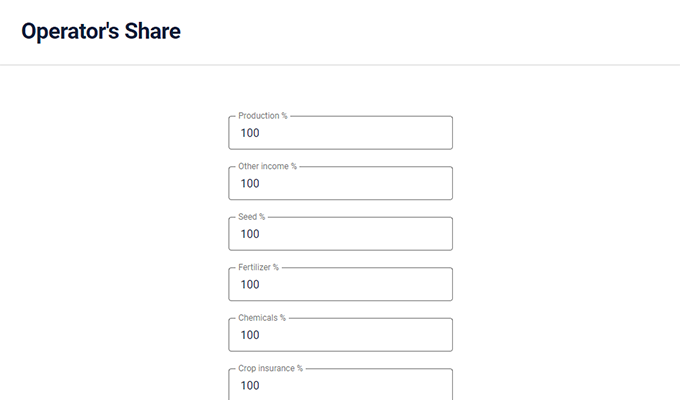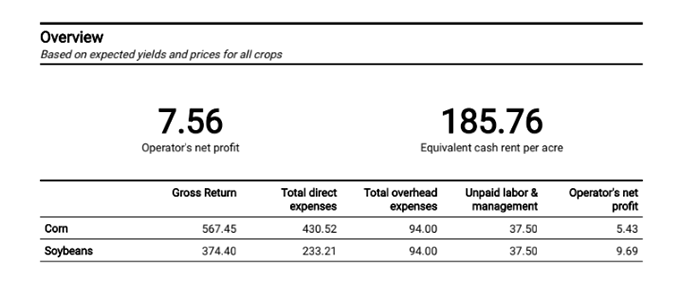Help
Getting Started
Intro to FairRent
FairRent helps farmers evaluate land rental decisions by estimating the breakeven rental rate after all other expenses. Use it to evaluate cash, share and flexible rental arrangements. Based on projected enterprise budgets for crop production, FairRent determines the breakeven rental rate at various yields and prices. The results suggest a range of affordable rental rates you can use in rental negotiations. For flexible arrangements, FairRent evaluates the risk for both the renter and the landlord. FairRent will help you bid for land rental tracts with confidence.
Check out the Start Guide below for a quick tour.
Create a FairRent Account
- To get started, go to https://fairrent.umn.edu/register.
- Here you will enter your account information, including email address and password.
- Click Register
- Welcome to FairRent!
Manage Your Account
- To manage your account, go to https://fairrent.umn.edu/account.
- Here you can update your account information including the ability to change your password.
FairRent Plan Types
FairRent includes nine different types of rental arrangements to choose from including Cash Rental, traditional Share Rental and seven different forms of Flexible Rental arrangements. Like share rental, flex rental arrangements provide a way for operators and landlords to share yield and price risk.
Cash Rent
Cash rental is the most common form of rental arrangement. Based on projected budgets for each planned crop, FairRent calculates the breakeven rental rate at expected yields and prices. In addition, given the uncertainty faced by producers and landowners, FairRent displays the breakeven rental rate should yields and prices be higher or lower than expected.
Flex on Percent of Gross
Under this arrangement, the operator pays rent equal to a percentage of actual gross revenue. Gross revenue is based on actual harvest yields and prices. FairRent calculates the rental rate (the estimated value of the landlord's percentage). It also displays the operator's projected net profit at various yields and prices.
Base Rent Plus Bonus on Yield Only
Under this arrangement, a bonus rental payment is paid if the actual yield exceeds the expected or base yield. FairRent calculates the projected rental rate and operator's net return at various yields and prices. Bonus on yield arrangements may be useful to negotiate a lower base rent in exchange for a bonus if actual yields are higher than expected.
Base Rent Plus Bonus on Price Only
Under this arrangement, a bonus rental payment is paid if the actual price exceeds the expected or base price. FairRent calculates the projected rental rate and operator's net return at various yields and prices. Bonus on price arrangements may be useful to negotiate a lower base rent in exchange for a bonus if actual price is higher than expected.
Base Rent Plus Bonus on Yield and Price
Under this arrangement, a bonus rental payment is paid if the actual gross revenue exceeds the expected gross revenue. Actual gross revenue is based on actual harvest yields and prices. FairRent calculates the projected rental rate and operator's net return at various yields and prices. Bonus on yield and price arrangements may be useful to negotiate a lower base rent in exchange for a bonus if actual revenue is higher than expected.
Flex on Yield Ratio Only
Under this arrangement, the rental rate can flex up or down from the base rent based on the ratio of the actual yield to the base yield. FairRent calculates the rental rate and operator's net return at various yields and prices.
Flex on Price Ratio Only
Under this arrangement, the rental rate can flex up or down from the base rent based on the ratio of the actual price to the base price. FairRent calculates the rental rate and operator's net return at various yields and prices.
Flex on Yield and Price Ratio
Under this arrangement, the rental rate can flex up or down from the base rent based on the ratio of actual yield to base yield and actual price to the base price. FairRent calculates the rental rate and operator's net return at various yields and prices.
Creating a FairRent Plan
In My Plans, select Create new plan to begin entering your plan details or click on the Plan Name to edit an existing plan.
Plan Details
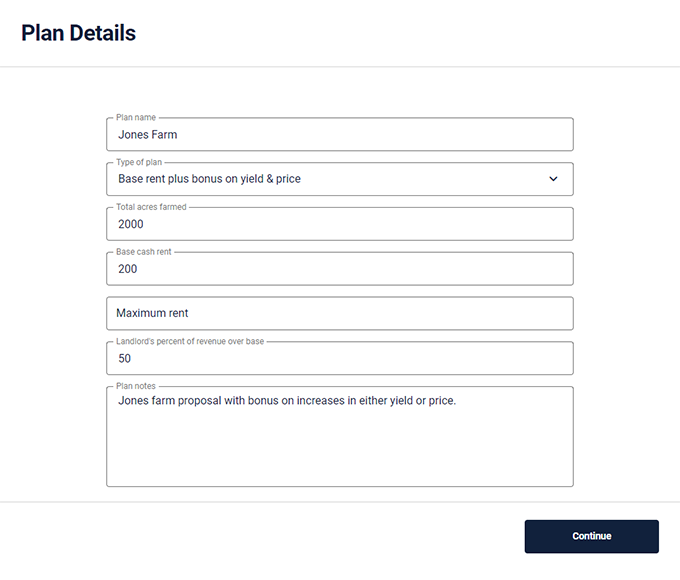
Plan name. Enter a name or description for your plan.
Type of plan. Select cash rental, share rental, or one of the seven flexible cash rent options from the dropdown. Learn more about the different FairRent plan types.
Total acres farmed. Enter the total crop acres that the operator expects to farm in the coming year including this rental acreage and all other owned and rented cropland. This will be used to allocate overhead expenses across all acres.
Base cash rent. For flex rent plans, this is the rental rate before any flex adjustments. For bonus rent arrangements, this is also the minimum rental rate.
Minimum rent (optional). If entered, this is the minimum rental rate that will be paid under a flex rental arrangement.
Maximum rent (optional). If entered this is the maximum rental rate that will be paid under a flex rental arrangement. If no maximum is entered, there is no maximum rental rate.
Landlord's percent of yield, price or revenue over base (for bonus arrangements only). This is the percentage of the extra yield, price or revenue that will be allocated to the landowner. For example, for Bonus Flex on Yield Only, if the actual yield is 10 bushels higher than Base Yield and the Landlord's percent of yield over base were 50%, then the rental rate will be increased by the value of 5 bushels. With a Base price of $4.00, a $20 bonus would be added to the base rental rate.
Crop Input
Enter a crop budget for each crop that will be grown on this rental acreage. Click Add New Crop to add a crop column.
Here are a few potential sources of budget information if past records of production and expenses are not available:
- FINBIN, select Crop Summary Reports to see enterprise production and expenses from the detailed records of thousands of producers;
- Ag Risk + Farm Management Budget Library, a catalog of budgets produced by various universities around the U.S.
Crop Input - Details
- Crop name. Enter the name of the crop and any further description that will identify this crop on the FairRent reports.
- Unit. Enter the unit of production (bushels, pounds, tons, etc).
- Acres. Enter the total acres that will be planted to each crop on this rental acreage.
- Expected yield. Use yield records, crop insurance records, or other information to project the most likely yield for this crop. FairRent will use this yield to project the breakeven rental rate. It will also center on this projected yield to show the impact of yield variability.
- Expected price. Use price forecasts, contract prices and other market sources to project the price for this crop. FairRent will use this price to project the breakeven rental rate. It will also center on this price to show the impact of price variability.
- Other income. Enter the value of projected government payments, secondary products or any other projected income related to these crops.
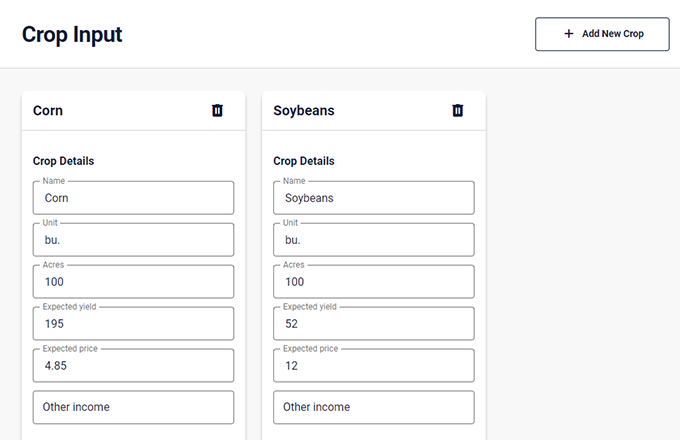
Crop Input - Flex Rent Options
These entries are dependent on the Type of Plan chosen.
- Landlord's percent of gross. For Flex on Percent of Gross arrangements only, this is the percent of gross income that will be allocated to the landlord. This percentage can vary by crop. It is common to allocate a higher percentage for crops with lower projected gross income.
- Flex base yield. For arrangements that flex on yield or gross revenue, the rental rate may change if the actual harvested yield is different than this base yield. If this yield differs from the expected yield entered in the Crop Details, the rental rate used in the main report may differ, or be "flexed," from the base rent.
- Flex base price. For arrangements that flex on price or gross revenue, the rental rate will change if the actual harvest-time price is different than this base price. If this price differs from the expected price entered in the Crop Details, the rental rate used in the main report may differ, or be "flexed," from the base rental rate.
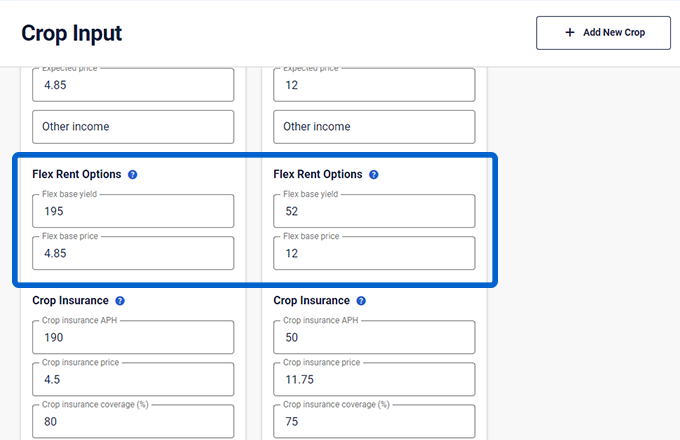
Crop Input - Crop Insurance
The crop insurance calculations demonstrate the risk protection provided for the operator at low yields and/or prices. Crop insurance proceeds are estimated assuming a Revenue Protection (RP) policy is purchased with the harvest price option. If crop insurance is not available or will not be purchased for these crops, leave the crop insurance entries blank.
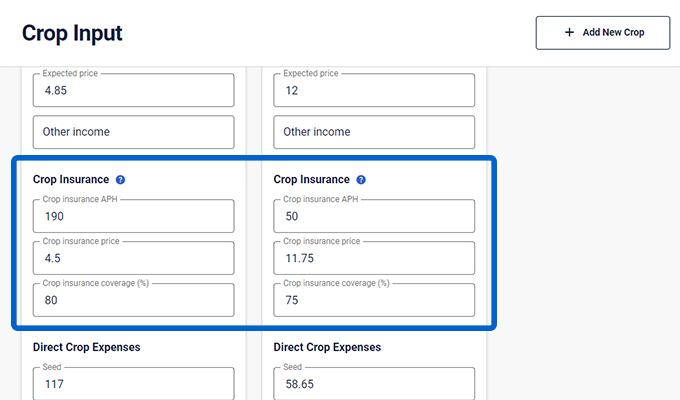
For cash rental plans, FairRent calculates the breakeven rental rate at various yields and prices and shows how crop insurance proceeds protect the operator at low yields and prices. For share rental plans, FairRent calculates the net return to the operator at various yields and prices and show how crop insurance proceeds protect operator returns at low yields and prices. For flex rent plans, crop insurance proceeds do not impact the calculated rental rate per acre. But based on the calculated rental rate, the analysis shows how crop insurance proceeds protect operator returns at low yields and prices.
- Crop insurance APH. Average production history, the landlord should be able to provide crop insurance yield history for covered crops.
- Crop insurance price. This price is announced by USDA prior to planting season. For plans completed prior to the price announcement, an estimate will have to be used. FairRent assumes the Harvest Price option, which increases coverage at prices that exceed this price as it evaluates the impact of varying yields and prices.
- Crop insurance coverage %. This is the percentage of any loss that will be covered. Coverage levels can vary between 50 and 100%. Most producers chose a level between 70 and 80%.
Crop Input - Direct Crop Expenses
Enter projected expenses per acre for seed, fertilizer, and other direct expenses for each crop. Use past records, projected input levels, and projected pricing to make projections as accurate as possible. If records are not available, FINBIN and the Ag Risk + Farm Management Budget Library may provide useful guidance.

Overhead Expenses
Select Overhead Expenses from the menu to estimate overhead expenses for your plan. Projected overhead expenses will be allocated equally per acre across Total Acres Farmed (entered on the Plan Details page).
- Total farm $. Based on past financial records, enter the estimated whole farm total for each overhead expense. This expense should cover existing acreage plus these additional rented acres.
- Crop portion %. Enter the estimated percentage of the total farm expense that will be for crop production (as opposed to livestock and other activities).
- Per acre $. The per acre expense is calculated by dividing the "crop portion" of each expense by Total Acres Farmed from the Plan Details page.
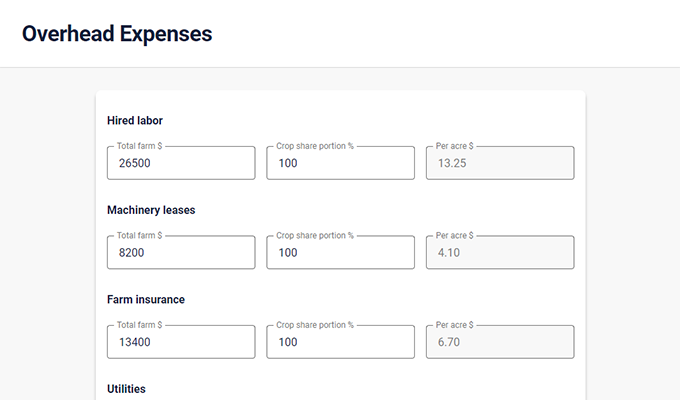
Operating interest, or interest on operating loans, is included in this section but in your results it will be listed in the Direct Expenses section. Operating interest per acre will vary slightly based on the amount of total direct expense projected for each crop.
Unpaid Operator Labor and Management should be included if owner compensation is not included in hired labor expenses. This ensures that projected breakeven rental rates provide a return to the operator.
Calculate Report
Select Calculate Report to see the results for your plan. FairRent Reports come in two forms, a screen preview and a downloadable pdf. The example below shows the first section of a screen preview. It displays the full results for the plan formatted to fit on your device. Click on Download Report to generate a PDF version of your report.
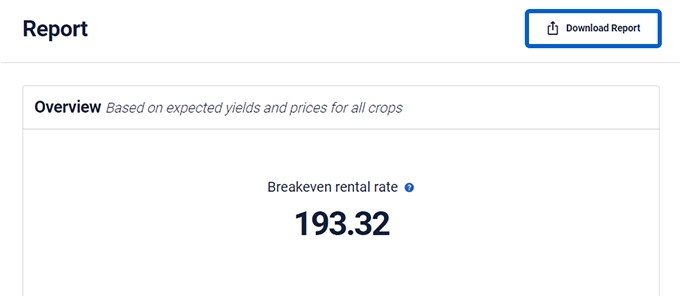
Understanding Your Report
Cash Rental Analysis
The first section of the report shows the calculation of the breakeven rental rate at the projected yields and prices.
Breakeven rental rate is the average of the amounts Remaining for rent across all acres. At the projected yields and prices, revenue will exactly cover expenses at this rental rate. The breakeven rental rate is weighted by the number of acres of each crop, so those crops with more acres have more impact on the average.
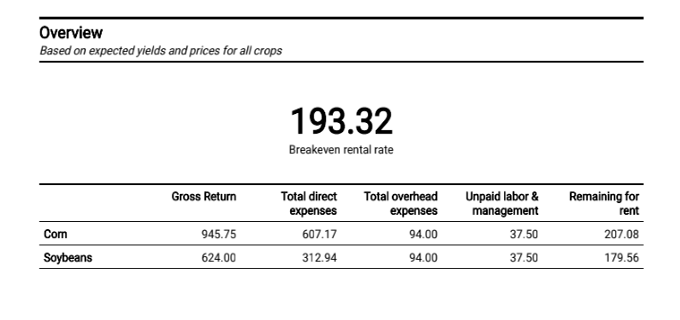
Maximum rent to cover expenses shows the rental rate that will allow the operator to cover varying levels of expense. In the long run, it is important that the rental arrangement allows the operator to cover all expenses, including unpaid labor and management. But in the short run, some overhead expenses like insurance may not change with more acres. So in some very competitive situations, the operator might consider paying a higher rental rate, even if it means not all expenses are covered. The Maximum Rent to Cover Expenses shows the amount that can be bid if the operator is willing to accept a lower return. For example, it may be that the landlord has an opportunity to rent land to someone else at a higher rate. In the short run, the current operator may be willing to accept lower labor and management returns if projected income at least covers overhead expenses. The amount that just covers direct expenses puts an absolute maximum on the amount that should be bid for cash rent. At this rate, the operator is getting no return for labor and management and the land is covering no overhead costs.
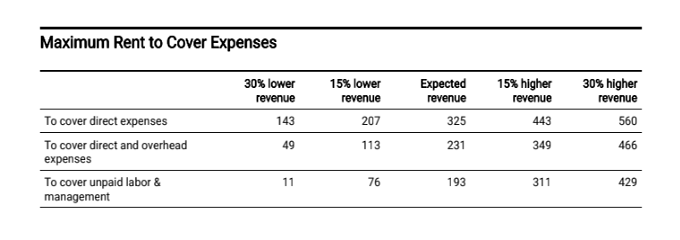
Breakeven cash rent at varying yields and prices. These tables show how the breakeven rental rate changes with varying yields and prices. A table is printed for each crop followed by a table showing the weighted average breakeven rental rates for all crops. If crop insurance items were entered, the lower end of the distribution (upper left) may be limited by expected crop insurance income.
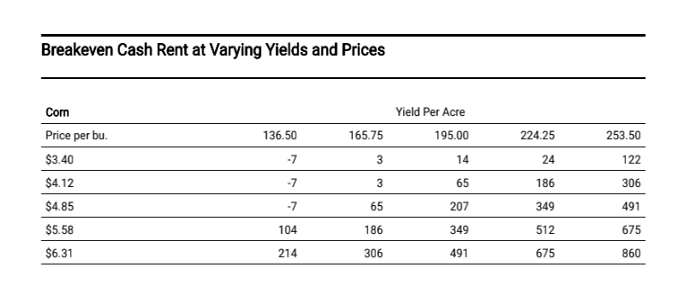
Flex Rental Analysis
The format of the reports for flex rent plans is the same for each plan type. The only difference is how the rental rate is calculated.
- Breakeven rental rate is the average of the amounts Remaining for rent across all acres. At the expected yields and prices, revenue will exactly cover listed expenses at this rental rate.
- Rental rate. For most plan types, the rental rate used in the first section of the report is the Base rent from the Plan Details page. If, however, Flex base yield or Flex base price are different from the projected yields and prices, the rental rate may be "flexed" to show the impact of these differences.
- Operator's net profit is the average return over all expenses, including unpaid labor and management, across all acres at this Rental rate. This is the difference between Breakeven rental rate and Rental rate.
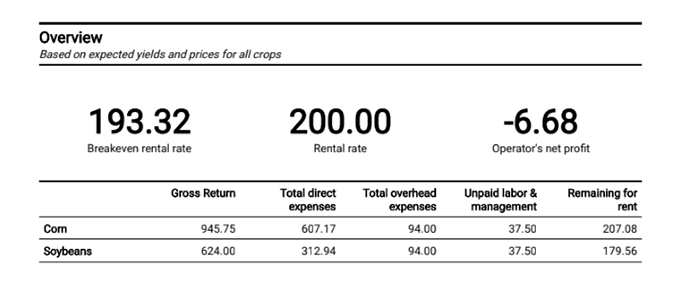
Rental Rate at Varying Yields and Prices displays the calculated rental rate based on the flexible arrangement at various combinations of actual yields and prices. These tables show the impact of the flex arrangement on the actual rental rate that will be paid. The plan below is a Base Rent Plus Bonus on Yield and Price plan.

The rental rate for each plan type is:
- Flex on percent of gross. Actual Yield x Actual Price x Landlord's Percent of Gross;
- Base rent plus bonus on yield only. If Actual Yield is less than or equal to the Base Yield, then rent equals the Base Rent. If Actual Yield is greater than the Base Yield, then rent equals Base Rent + ((Actual Yield - Base Yield) * Landlord's Share of Yield over Base * Base Price);
- Base rent plus bonus rent on price only. If Actual Price is less than or equal to the Base Price, then rent equals the Base Rent. If Actual Price is greater than the Base Price, then rent equals Base Rent + ((Actual Price - Base Price) * Landlord's Percentage of Price over Base * Base Yield)
- Base Rent Plus Bonus on Yield and Price. If the Actual Gross Revenue (Actual Price x Actual Yield) is less than or equal to the Base Revenue (Base Price x Base Yield), then rent equals the Base Rent. If Actual Revenue is greater than the Base Revenue, then rent equals Base Rent + ((Actual Revenue - Base Revenue) * Landlord's Share of Revenue over Base)
- Flex on Yield Ratio Only. The Rental Rate equals Base Rent x (Actual Yield ÷ Base Yield)
- Flex on Price Ratio Only. The Rental Rate equals Base Rent x (Actual Price ÷ Base Price)
- Flex on Yield and Price Ratio. The Rental Rate equals Base Rent x (Actual Yield ÷ Base Yield) x (Actual Price ÷ Base Price)
Rental rates under each arrangement may be limited by the Minimum rent or Maximum rent entered in Plan Details.
Operator's Net Profit at Various Yields and Prices displays the amount remaining after paying all expenses including the calculated rental rate at various combinations of yield and prices. Expenses include Unpaid labor and management if entered. As in the example below, crop insurance may limit how low Net Return will go at very low combinations of yield and prices.
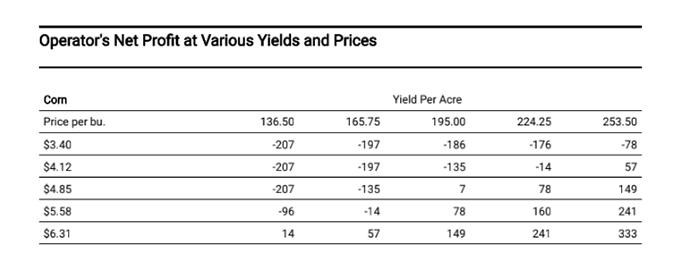
Flex Rent Plan - Considerations
- For Flex on Percent of Gross Arrangements, the Landlord's Percent of Gross can be different for each crop. In many areas the gross revenue from corn, for example, is higher than gross revenue from soybeans, so it is common to specify a higher Landlord's Percent of Gross for soybeans. It may be helpful to calculate the typical cash rent as a percentage of gross revenue for your area. The lease agreement should specify if crop insurance proceeds are to be included in gross revenue for this calculation. The FairRent calculations do not share crop insurance proceeds with the landlord.
- For Bonus Rent arrangements, the Landlord's Share of Yield/Price/Revenue over Base must be specified in the agreement.
- Base rent is the rental rate that will be paid if actual yields and prices do not result in a flex adjustment. For Bonus arrangements, "This base rent is typically discounted from the 'market' rent due to additional risk being passed on to the operator" (North Central Farm Management Extension Committee, 2011) .
- Base Yield must be agreed upon by the operator and the landowner. This may be the average or expected yield for each crop produced on the rental acreage.
- Base Price must be agreed upon by the operator and the landowner. This is generally the expected price for each crop produced on the rental acreage at the time of lease agreement.
- Actual Yield is the yield per acre measured at harvest or at delivery. The method used to verify yields should be specified in the lease agreement.
- Actual Price is generally the price at a specific time in the future or over a period of time in the future. The method of calculating the actual price should be clearly specified in the lease agreement. For example, "the average closing price at Anytown Elevator during the period September 15 to November 1" (North Central Farm Management Extension Committee, 2011) .
- Minimum and maximum rental rates can be set in the rental agreement. Landlords will generally require a minimum rate that provides them some return on their investment. If a maximum is set, all revenue over this maximum will go to the operator.
Manage Your Plans
Plans can be copied, shared and deleted on the My Plans page. Click on the more icon to access the manage plan options.
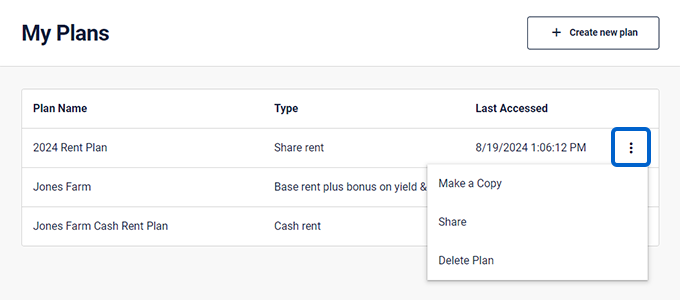
- Make a copy. A copy of the plan will be created and added to the plan list with a plan name of "Copy of ..." Copied plans can be changed to other plan types. This means that you can enter Crop Details once, then make copies of the plan and change the plan type to analyze other arrangements.
- Share. Plans can be shared with other users of the FairRent app. Enter the user's Email address to share the plan. The other user must be a registered FairRent user.
- Delete plan. You will be prompted to click Delete Plan to remove a plan from the My Plans list.
Resources
- North Central Farm Management Extension Committee. 2024. "Fixed and Flexible Cash Rent Lease Agreements for Your Farm"" NCFMEC-01. North Central Regional Cooperative Extension Services.
- FINBIN
- Ag Risk + Farm Management Budget Library
